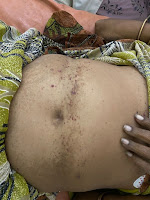Internal assesment 5/9/2020
1)1 Anatomical diagnosis : Renal system as decreased urine output and albuminuria ( explaining her B/L pedal edema abdominal distension and fascial puffiness : Glomerular pathology
Etiological diagnosis: systemic illness Hypertension ,Diabetes causing diabetic nephropathy( nephrotic range proteinuria in a diabetic is taken as diabetic nephropathy unless otherwise proven)
2)Reason for azotemia : No hydroureteronephrosis with normal renal size and intact parenchyma with abnormal urine analysis : Hematuria and proteinuria ( glomerulonephritis /vasculitis)
? Glomerulonephritis reason for azotemia.
Anemia : Looking at her peripheral smear microcytic hypochromic anemia : Iron deficiency anemia.
Hypoalbuminemia: proteinuria ( because of glomerular barrier damage)causing hypoalbuminemia.
Acidosis: high anion gap metabolic acidosis ( failure to excrete acids) Acute / Chronic renal failure.
3)https://www.ncbi.nlm.nih.gov/pmc/articles/PMC3946919/
Chronic metabolic acidosis may have various adverse effects in patients with CKD (Table 2) on bone disease, insulin resistance, and muscle wasting, and it may contribute to the progression of kidney disease. Chronic acidosis results in negative calcium balance from bone buffering, which is ameliorated by treatment with alkali.19
4)Her worseing metabolic acidosis day to day with persitant anuria despite treatment with fluid challenge and diuretics was the reason for taking her to dialysis
5)Amyloidosis , obesity , mixed connective tissue disorders or drugs (Nsaid) apart from hypertension diabtes.
Primary : Minimal change disease, Focal segmental glomerulosclerosis, Membranous nephropathy.
Secondary : DM, SLE, HIV , Viral hepatitis, malaria, amyloidosis, Sarcoidosis, Drugs : Nsaids, gold, pencillamine Cancer: Hodgkin's and non Hodgkin's, solid tumours of GIT, RCC and lung.
6)association of ckd with hfpef
Activation of raas system
Anemia
Hypercalcemia
Hyperphosphatemia
Uremic toxins .these critically discuss the potentail contribution to coronary dysfunction, left ventricular stiffening and delayed left ventricular relaxation
7)Mechanistically, Edwards et al. showed that CKD stage 2 and 3 is associated with reduced aortic distensibility, increased arterial elastance, increased end‐systolic elastance, reduced early diastolic (e') tissue velocities and increased LV diastolic stiffness. Thus, patients with CKD stage 2 and 3 resemble early HFpEF even before the onset of overt HF.27
Although we demonstrated an association between CKD and adverse cardiac mechanics, the direction of this association cannot be ascertained given the cross‐sectional design of our study. CKD may be a pathogenic factor that results in abnormal cardiac mechanics. However, it is also quite possible that underlying abnormalities in cardiac structure/function in HFpEF contribute to the development of CKD. Worse diastolic function and abnormal cardiac mechanics could lead to reduced cardiac output and/or increased renal venous congestion, thereby leading to worse renal function in HFpEF. In reality, it is probably a two‐way association that leads to the detrimental cardiorenal interactions in HFpEF patients.
https://onlinelibrary.wiley.com/doi/full/10.1002/ejhf.445
8)there was a marked improvement in measures of anaemia with the treatment and a decrease in the number of participants requiring blood transfusion. Though difficult to summarise, the data from all studies which reported quality of life or exercise capacity demonstrated an improvement in the rHuEPO group.
https://www.ncbi.nlm.nih.gov/pmc/articles/PMC7144724/
9)
10)Malnutrition is an important complication in CRI patients and ESRD patients on dialysis. SGA is a reliable method of assessing nutritional status. Most important is the fact that it can detect the changing trend of nutritional status, which may be missed by one-time anthropometry and biochemical methods.
And chronic acidosis in a CRF patient causes decrease albumin synthesis and increased protein degradation causing negative nitrogen balance.
https://www.ncbi.nlm.nih.gov/pmc/articles/PMC3946919/
2)58 yr old male with diabetes and hypertension has no proteinuria and unlikely it could be a diabetic nephropathy
His symptoms were acute suggesting an acute kidney injury (? Pre renal) as responding well to IV fluids and diuretics and presently the patient is subjectively better with no fever spikes and his serum creat has come down from 8.5 to 3.6 (today) and urea dropped down to 110 and patient is walking around with no complaints.


Live Testimony: I am greatful to Dr Itua ,the powerful herbal healer that rescued me from HIV/AIDS and HERPES. I was diagnosed of these disease since 2012 and because of this, i was very unhappy with my life and i went into research on how i can get cured and i saw a testimony of a lady on how she was cured from HERPES by Dr Itua , i decided to give him a try and when i contact him, he assure me that he will help me and send me the cure and i believed in him because all i wanted was to be cured, so he prepared a herbal cure for me and send it to me through DHL and gave me instructions on how to use it and after one week i should go to hospital for checkup and after one week of using the herbal medicine, i went to the hospital for test and to my surprise the test stated that i am HIV/AIDS with HERPES negative and i am fully cured from the diseases. This gladdens my heart and everybody in the hospital was surprised even the Medical Doctor, So viewers Dr Itua is a God Gifted man and he can cure so many diseases like HIV/AIDS, HERPES,CANCER of all kind, PILE, KIDNEY PROBLEM, SYPHILIS, DIABETICS and lot's more. You can contact him through his email:drituaherbalcenter@gmail.com or call and whatsapp him on +2348149277967 . I will continue to share this great testimony on the internet and all over the world for the good job Dr has done for me.///
ReplyDelete